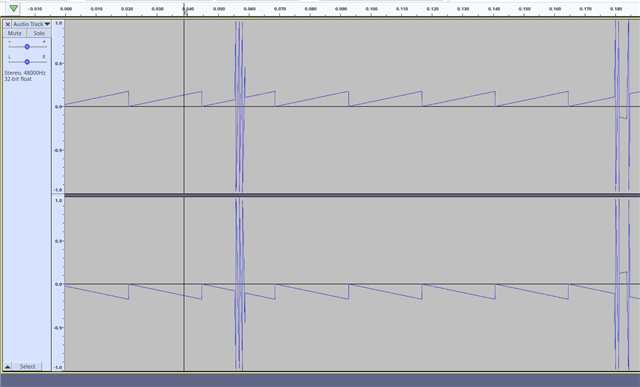Hi,
I'm trying to use an nRF52840 dev kit as an I2S-to-USB microphone, but I've been running into a problem where the recorded audio is periodically unusable.
To debug, I connected another nRF52840 dev kit to act as an I2S slave. It simply delivers a repeating sawtooth waveform.
I can receive this on my primary dev board and send it to the host PC over a USB audio interface. Here's what I record in Audacity:

As you can see, the sawtooth is clearly visible, but every 6000 samples or so, I see these strange spikes. I think the problem lies with the USB transfer, because I've done some quick checks to make sure the received I2S data is as expected.
To transmit data over USB, I use the following function:
bool write_to_usb(struct net_buf *buffer, size_t size){
int ret;
if (!buffer || !size) {
LOG_ERR("BUFF NULL!");
/* This should never happen */
return 1;
}
/* Check if OUT device buffer can be used for IN device */
if (size == usb_audio_get_in_frame_size(mic_dev)) {
ret = usb_audio_send(mic_dev, buffer, size);
if(ret){
net_buf_unref(buffer);
return 1;
}
} else {
LOG_ERR("In frame not equal to size. Found %d, expected %d", usb_audio_get_in_frame_size(mic_dev), size);
net_buf_unref(buffer);
return 1;
}
return 0;
}
This function is called from my nrfx I2S handler:
struct net_buf *buf = net_buf_alloc(&netbuf_pool, K_NO_WAIT);
if(buf){
int16_t* rx_aud = (int16_t*) p_released->p_rx_buffer;
// Copy data from I2S to USB audio
for(int i = 0; i < SAMPLES_PER_CHUNK; i++){
net_buf_add_le16(buf, rx_aud[i]);
}
write_to_usb(buf, CHUNK_SIZE_BYTES);
}
The net buffer pool is initialized like so:
NET_BUF_POOL_DEFINE(netbuf_pool, 50, CHUNK_SIZE_BYTES, 0, NULL);
Am I using the net buffer incorrectly here?
I've attached the project files for both dev boards for reference.


